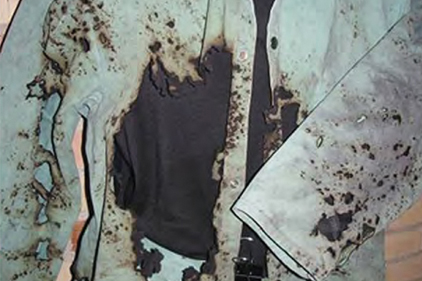Many workers who daily confront exposure to flame, extreme heat, molten metal, hot liquids, and arc flash routinely wear a simple cotton T-shirt and briefs as their “protective” base layer. They may also wear typical cotton “greens” or jumpsuits, shirts and coveralls that are chemically treated to be flame resistant. This common PPE combination is relatively inexpensive and permitted under current industry safety standards and regulations, but does it offer the level of protection required for the risk?
Most fabrics made of natural fibers, like cotton, and most synthetic fibers will burn or melt when exposed to a flame or electric arc. Flame-resistant (FR) fabrics ignite with difficulty, burn slowly when set on fire, and most importantly, self-extinguish when the heat source is removed. FR fabrics are produced in one of two ways: Either the fabric is made from inherently FR fibers or a non-FR fabric is chemically treated to provide FR properties.
Inherent FR fabrics are made of fibers in which the FR properties are naturally part of the polymer backbone and can never be worn away or washed out. The actual structure of the fiber itself is non-flammable; therefore, the flame trait is permanent.
Treated FR fabrics are created by applying a flame-retardant chemical finish to a fabric or by adding a chemical treatment to the fibers before they are woven or knitted into the fabric. The chemicals form a strong bond with the polymer chain that is difficult to remove by washing when the recommended laundering instructions are followed accurately. The chemical treatment alters the molecular structure of the polymer.
Pro’s and con’s of inherent FR fabrics
FR protection mechanism: The primary advantage of inherent FR fabrics is the high level of protection against thermal hazards. Inherent FR fabrics will not ignite in normal oxygen content levels, or they will char as their protection mechanism.
Other inherent FR fabrics off-gas to prevent combustion. While this method will not support a flame, it offers minimal protection and can release hazardous chemicals, such as cyanide, as the flame is extinguished.
When exposed to heat or flame, inherent FR fabrics made of a blend of oxidized fibers carbonize and then expand, eliminating any oxygen content within the fabric, and provide superior insulation. Oxidized fibers are thermally stable and do not shrink during thermal exposures. Shrinkage during a thermal exposure decreases the air layers between fabric and skin, which ultimately reduces the overall insulation provided.
Inherent FR fabrics consistently have higher Thermal Protective Performance (TPP) scores than treated FR fabrics. The TPP rating is a measurement of a protective garment’s thermal insulation performance against convective and radiant heat exposure. A garment’s TPP score is simply two times the number of seconds it takes for a second-degree burn to occur when exposed to a 2.0 cal/cm2 flame and radiant heat source. The higher the TPP rating, the higher the level of protection provided by the garment.
Permanent protection: The FR properties of inherent FR fabrics will not wash out or wear away.
Higher upfront price, but greater long-term value: Inherent FR fibers are typically more expensive than treated fibers. But the effectiveness of the thermal protection during the lifetime of the garment may allow a more expensive garment to be worn for a longer period of time. The higher upfront price for inherent FR apparel can be justified over the long term when its durability extends the life of the garment.
Improved comfort: To compete with comfort-driven treated FR fabrics, PPE fabric and clothing manufacturers using inherent FR fibers have developed lighter-weight solutions. NFPA 70E Hazard Risk Category 2 rated garments continue to get lighter, and more flexible and lightweight options for extreme environments are now available. Inherent FR garments are also now designed with increased breathability and improved moisture management.
Pro’s and con’s of treated FR fabrics
Enhanced comfort: Workers want to wear organic fibers like cotton and other cellulosics because they are comfortable — even after they are chemically treated. Treated FR fabrics are both lightweight and flexible.
FR protection mechanism: When exposed to direct flame, some treated FR fabrics rely on a chemical reaction to extinguish the flame. This reaction is triggered by the heat of the fire and the amount of time the fabric is exposed to the flame. Other treated FR fabrics char as their form of protection or off-gas to prevent combustion.
Longer lifespans: New advances in finishes have helped lengthen the lifespans of treated FR fabrics, as long as proper laundering procedures are followed. Treated FR garments, however, may be damaged by chlorine bleach, the combination of hydrogen peroxide (“oxygen bleach”) with hard water, or exposure to oxidizing chemicals in the workplace. Unfortunately, a wearer is not able to tell if a treated FR garment is no longer flame resistant simply by looking at it.
Inexpensive alternatives: With their shorter lifespans, treated FR fabrics tend to be less expensive upfront than inherent FR fabrics. This can be a primary driver in the PPE decision-making process.
Mass matters
Treated FR fabrics are often heavier in weight than inherent FR fabrics. In such instances, treated FR fabrics appear to perform better than inherent FR fabrics. The more mass that can be placed between the wearer and the hazard (be it molten metal, arc flash, flame, or even cut protection), the better.
But with increased protection (i.e., weight) comes trade-offs in comfort. Treated FR garments, once regarded for their maximum comfort levels, may contribute to additional heat strain at heavier weights.
For both inherent FR fabrics and treated FR fabrics, protection is easy. Balancing it with comfort, durability and economic factors is where it becomes difficult.





